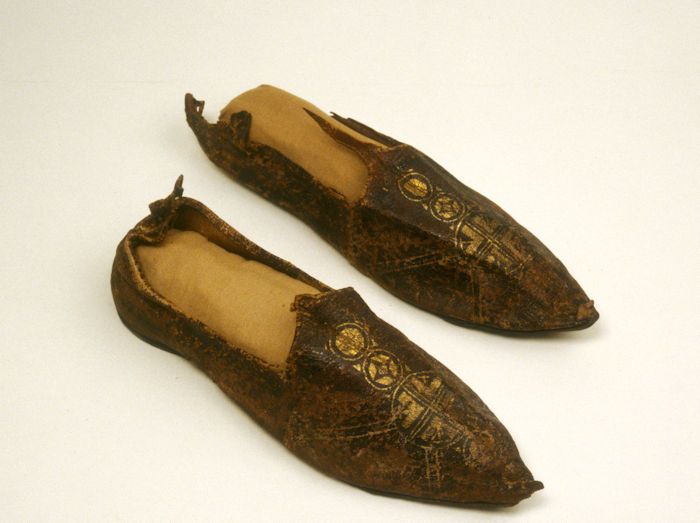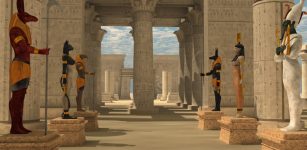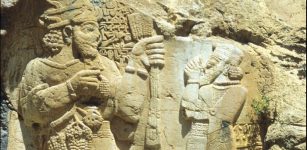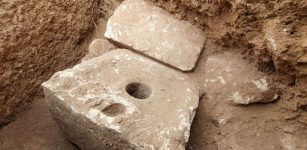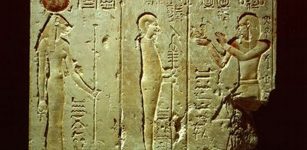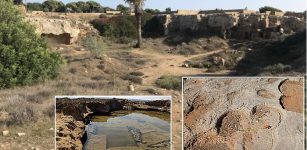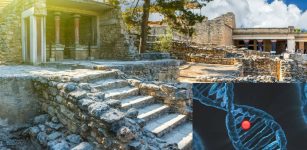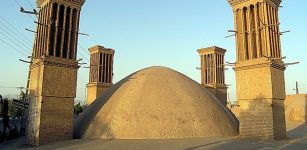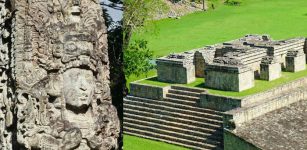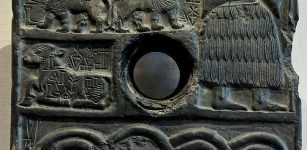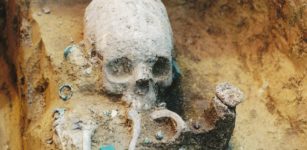Byzantine Sandals With A Nice Message Found In The Harbor Of Eleutherios (Theodosius) – Now On Display
Conny Waters - AncientPages.com - A pair of nice sandals were discovered during excavation works at the Harbor of Eleutherios (Theodosius), one of the ports of ancient Constantinople, the capital of the Byzantine Empire, located beneath the modern Yenikapi neighborhood of Istanbul, Turkey.
The 1,500-year-old sandals belonged to a Greek woman and have a message in Greek which reads: “Use in health, lady, wear in beauty and happiness.”
These Byzantine sandals belonged to a woman and were found during a dig in Istanbul. Credit: Twitter/@NkayaMuhittin
The beautiful Byzantine sandals are now on display at the Istanbul Archeological Museum. "The museum complex, which was the first museum in Turkey, contains more than 1 million artifacts belonging to the civilizations once within the borders of the Ottoman Empire." 1
"The Byzantines loved color and patterns, and they made and exported very richly patterned cloth, especially Byzantine silk, which was woven and embroidered for the upper classes and resist-dyed and printed for the lower.
Modesty was important for all, and most women appeared to be almost entirely covered by rather shapeless clothes. There has been a considerable amount of footwear recovered in this excavation project, with sandals, slippers and boots to the mid-calf, seen commonly in manuscript illustrations, also found in the dig. Many of the items are richly decorated in various ways.
The color red, reserved for Imperial use in male footwear, is actually by far the most common color for women’s shoes. Purses are rarely found, and seem to have been made of textile matching the dress, or perhaps tucked into the sash." 2
A par of Byzantine sandal. The central motif of a cross suggests that this pair of leather shoes was made for a priest, although an upper-class man could have also worn them. Many poor people in this period went barefoot, including shoemakers, while those who could afford to wore sandals (government officials); slippers (monks and clergy); or boots (soldiers and laborers). Credit: Walters Art Museum - Public Domain
The Harbor of Eleutherios (Theodosius) is of great archaeological and historical importance. Built in the late 4th century, during the reign of Theodosius I, it was the city's major trade point in Late Antiquity.
"In the harbor area, as well as in several other parts of today’s Istanbul, there are traces of Iron Age settlements. Thracians also settled in the region: their settlement was, according to ancient tradition, called Lygos.
View of Constantinople. – (Hartmann Schedel, Liber chronicarum [Nürnberg 1493] fols CXXIXv, CXXX. Credit: Public Domain
Hellenization of the peninsula began in the seventh century BC, as settlers from Megara, Argos and Corinth arrived, led, according to legend, by the hero Byzas. This first Greek settlement, named Byzantium after the hero, replaced the Thracian settlement. It was on the headland at the entrance to the Golden Horn, the area of modern Topkapi Saray (Saray-burnu); however, its exact position and dimension remain unknown.
The harbor facilities of this early settlement were located in the area of the Golden Horn, which favored landings due to the geomorphological condition and its sheltered places. For centuries, until late Antiquity, the favored anchorages of the settlement were located here." 3
An ancient statue of Greek goddess Tyche on display at the Istanbul Archeological Museum. Credit: AA photo
Excavation works started in November 2005 when the Marmaray project discovered the silted-up remains of the harbor. Scientists realized the finding was part of something much bigger, and the long-lost ancient harbor was found. Over the years, archaeologists have made many amazing discoveries at the site. Archaeologists have "uncovered traces of the city wall of Constantine the Great, and the remains of over 35 Byzantine ships from the 7th to 10th centuries, including several Byzantine galleys, remains of which had never before been found." 2
There is also evidence this is the oldest settlement in Constantinople, and scientists have unearthed pottery, animal and human bones, and skulls dating back to 6000 B.C
Istanbul Archeological Museum is without a doubt filled with incredible ancient artifacts, and among them, we find the beautiful Byzantine sandals wishing the wearer good health and luck.
Written by Conny Waters – AncientPages.com Staff Writer
Expand for references- Daily Sabah - Istanbul Archaeology Museums offer most-admired collections
- Tasos Kokkinidis - The 1,500-Year-Old Lady’s Sandals with Sweet Message in Greek - Greek Reporter
- Andreas Kuelzer - The Harbour of Theodosius in Yenikapi, Istanbul: A Harbour Area through the Ages, DOI:10.11588/propylaeum.911.c12066


